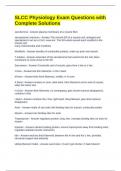SLCC Physiology Exam Questions with
Complete Solutions
sarcolemma - Answer-plasma membrane of a muscle fiber
sarcoplasmic reticulum - Answer-The smooth ER of a muscle cell, enlarged and
specialized to act as a Ca2+ reservoir. The SR winds around each myofibril in the
muscle cell.
many mitochondria and myofibrils
Myofibirls - Answer-bundles of contractile proteins, make up actin and myosin
T tubules - Answer-extension of the sarcolemma that extend into the cell, allow
membrane to come close to the SR
Sarcomere - Answer-Contractile unit of muscle, goes from z line to z line
z lines - Answer-link thin filaments. in the I band
M lines - Answer-links thick filaments, middle, in H zone
A band - Answer-contains H zone, dark band, thick filaments end to end of myosin,
stays the same size
H Zone - Answer-thick filaments, no overlapping, gets shorter (almost disappears),
contains m line
I band - Answer-contains the z line, light band, thing filament, gets short (almost
disappears)
Actin - Answer-made of sub units with binding sites for myosin, contractile protein
Myosin - Answer-has binding sites for actin
Tropomyosin - Answer-regulatory protein, long, thin, overlaps binding sites on actin for
myosin
troponin - Answer-calcium binding protein, moves tropomyosin away from binding sites,
regulates skeletal muscle contraction
titin - Answer-anchors thick filaments between the m line and the z line, provides
structural support and elasticity
sliding filament model - Answer-sarcomere, H and I get shorter, H band doesn't
, cross bridge cycle - Answer-sequence of events between binding of a cross-bridge to
actin, its release, and reattachment during muscle contraction
excitation-contraction coupling - Answer-events that link the action potentials on the
sarcolemma to activation of the myofilaments, thereby preparing them to contract
isometric concentration - Answer-length is constant, generates tension, load not lifted,
load > tension
isotonic contraction - Answer-muscle shortens because muscle tension exceeds load,
load is lifted as muscle shortens
summation - Answer-action potential, contraction, contractions can overlap and sum,
add to contraction by triggering another action potential.
tetanus - Answer-causes our muscles to stay contracted over time
fiber diameter - Answer-increased diameter --> increased myofibrils in parallel -->
increased force production
true - Answer-if the length of the muscle is too long less tension is produced, when the
muscle is too short it also doesn't produce much tension
motor unit - Answer-a single motor neuron and all the muscle fibers it innervates
recruitment - Answer-stimulating more muscle fibers to contract by adding more motor
units
slow oxidative fibers - Answer-contract slowly, have slow acting myosin ATPases, and
are fatigue resistant, requires oxygen, have myoglobin which gives the red color
ex: posture
fast oxidative fibers - Answer-contract quickly, have fast myosin ATPases, and have
moderate resistance to fatigue, requires oxygen and has myoglobin
Fast Gylcolytic fibers - Answer-fast, running and fast motions, no myoglobin, larger
diameter, fatigue rapidly, lighter in color, glycolysis for energy
muscle spindles - Answer-spiral stretched more frequent action potential, bundled less
frequent action potential. brain can interpret mechano receptors (pro-preceptor)
Golgitendon organs - Answer-in the tendon can tell if the tendon is stretched or not (pro-
preceptor)




